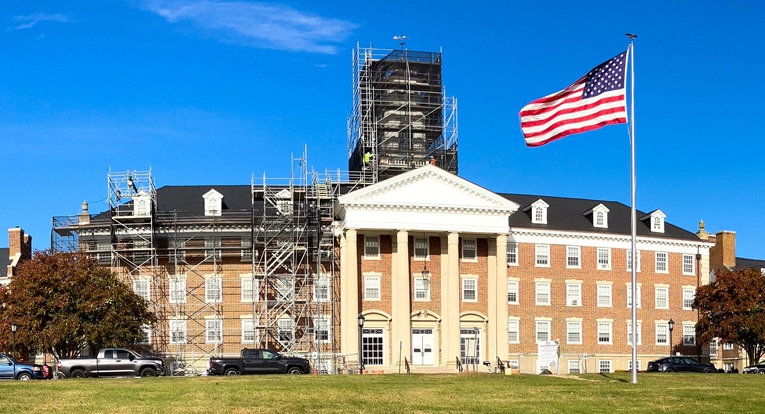The March 11 Greenbelt City Council meeting was a wide-ranging discussion on the issues of deploying small cell facilities throughout the city, the creation of a memorial wall honoring historic doers for Greenbelt and the quickly changing coronavirus pandemic.
The meeting began with the virus and how the city could best adapt to these uncertain circumstances. The focus was on temporarily cancelling various programs, specifically senior classes and large-scale gatherings like the upcoming ACE awards, and whether it was better to be safe than sorry. Concerning the awards, questions were brought up about the essential importance of such an event with the consensus being on the side of public safety. Mayor Colin Byrd stressed that council was in the leadership position of making objective decisions for the community, regardless of possible dissent.
Small Cell Towers
Attorney Joe Van Eaton, from Best Best and Krieger (BBK), and Shawn Thompson, principal engineer from CTC Technology and Energy, provided an update on the effort to deploy small cell towers in Greenbelt. BBK, which has worked with the city for over 30 years, was brought on to draft a small cell ordinance for the city. CTC was asked for a proposal that would help support Greenbelt with engineering and application expertise related to wireless facility siting, according to Andrew Afflerbach, chief executive officer and chief technical officer of CTC, and effectively respond to changes in the industry and the Federal Communication Commission’s regulatory framework, according to their proposal. A recent 2018 FCC preemption order changes the dynamic between local governments and the wireless companies by giving the companies low-cost, streamlined access to public property to mount wireless facilities, said their proposal.
According to Van Eaton, a typical small cell tower pole can be up to 55 feet high. A facility consists of 3 cubic feet of antenna and a 28-cubic-foot box. Small cell is deployed to enhance the larger cellular data/ internet network. Its range varies from 500 to 1000 feet and the equipment can be attached to already existing infrastructure like rooftops or streetlights, if a pole is not feasible.
According to the CTC proposal, over a million small cell antennas will augment tower and rooftop cells in public rights-of-way nationwide.
According to Beverly Palau, the city communications coordinator, “the ordinance is in good shape but we might make some small changes,” especially in response to the FCC ruling, “to get an ordinance that protects Greenbelt.”
The small cell ordinance was enacted on December 10, 2018. It lays out procedures and rules for deployment and application review, with the city manager at the helm of all final deliberations. Public safety, minimization of the visual impact and right-of-way considerations were some of the major points covered.
The major discussion over the ordinance concerned the creation of an additional city design manual that would stipulate in detail things like height, placement and general aesthetics. According to Van Eaton, the ordinance “set up very short standards” on these things to allow the city to “make that choice.” Having a separate manual would mean not having to convene public meetings to make changes.
CTC’s Thompson said that a manual could be assembled in roughly three months.
Van Eaton asserted, though, that the city would need to be careful that their choices do not violate the new FCC requirements, which require that any installation not be a burden. Councilmember Judith Davis agreed that any choices be reasonable. Van Eaton went on to say “that it is not a simple process,” requiring “public comment that can often hold things up at the design phase.”
The CTC proposal was in three parts. The first deals with review recommendations to the ordinance and future applications, as well as on-call technical support to wireless facilities. The second concerns proper vetting of applications, setting safety and technical standards, staffing needs, processes to address issues with the FCC laws, Smart Cities strategies and public safety. The third presents the state of similar and current projects in Baltimore City, Montgomery County and the Texas Department of Transportation.
City Solicitor Todd Pounds encapsulated CTC’s role as “a turnkey operation,” which reviews each application and makes recommendations to the city.
Palau said that the proposal “sounds like a wonderful idea,” and that an agency like CTC was necessary as there is “no one on staff with this expertise and knowledge.” She said she would expect to put the proposal on the next agenda for council approval, after which “we will have CTC review all our documents and suggest any changes we might need.”
Wall
The meeting ended with a debate on how to proceed with the long-discussed memorial wall. It was over the choice of either using an off-the-shelf tree design or sending out the community for ideas, which had proved unfruitful. It was pointed out by Davis that the former would be quicker and cheaper and would require money allocated in the budget, of which there is none currently. Assistant City Manager David Moran pointed out that in the past this approach had resulted in push-back from the community for its lack of Greenbelt’s trademark uniqueness. Davis countered that “the scope of possible choices is much better now.”



